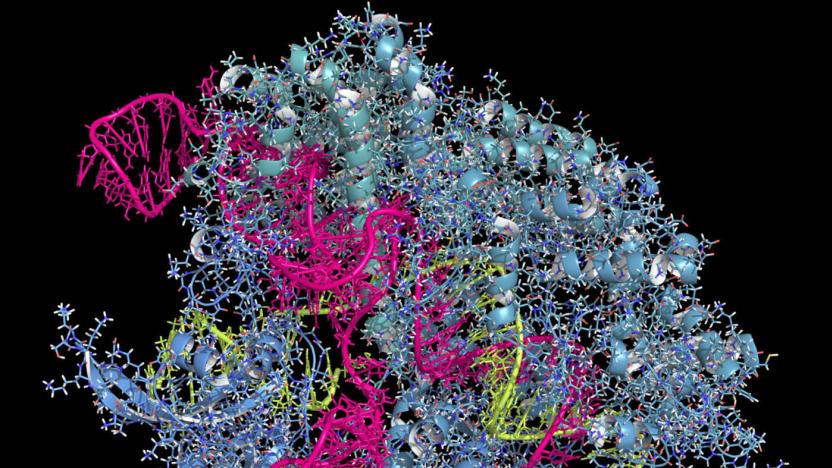Harvard
Latest

ICYMI: Cellphone motor as mic and fuel from sunlight
try{document.getElementById("aol-cms-player-1").style.display="none";}catch(e){}Today on In Case You Missed It: Researchers created a hack that lets a smartphone's vibration motor act as a microphone, picking up conversations unbeknownst to the user. Harvard University folk created fuel using artificial photosynthesis that is triple as effective as previous systems, making gas out of sunlight, CO2 and water. And finally, YouTube user BOOM LLC Robotater has a pretty entertaining potato video on the site; if you're looking for the case that lets you switch an iPhone to Android, that's here. As always, please share any great tech or science videos you find by using the #ICYMI hashtag on Twitter for @mskerryd.

Tiny 'metalens' could bring SLR camera quality to your phone
Your smartphone's camera quality is limited for a number of reasons (sensor size, for example), but one of the biggest factors is optics: you need a lot of glass to deliver the pin-sharp photos of a DSLR or mirrorless camera. That's where Harvard researchers might help. They've developed a "metalens" that substitutes the usual glass with quartz plates full of microscopic titanium oxide structures, whose patterns guide light toward the camera sensor. The technology not only leads to a much smaller lens (it's just 0.08 inches across in testing), but focus that beats even the better lenses you find in stores -- it can resolve details 400 nanometers wide, or smaller than a wavelength of light.

Artificial 'leaf' could beat real plants at converting sunlight
Natural photosynthesis is considered a good target for solar energy conversion, but it's already considered old hat. Harvard scientists have developed a leaf-like system that should be more effective at converting solar energy than plants themselves. The technology boils down to a jar of bacteria (Ralstonia eutropha), a cobalt water-splitting system and a pair of electrodes. When you send electricity through this partly biological system, the electrodes turn the water into hydrogen gas that you can use for fuel and carbon-based materials. It's only 10 percent efficient, but that's better than the widely established 8 percent baseline for real-world performance.

Harvard's RoboBee uses static to stick to surfaces
Harvard's tiny robotic bee has learned how to stick to surfaces like Spiderman. Unlike spiders that use thousands of tiny hairs to climb walls, though, the upgraded RoboBee uses the power of static electricity. A team of engineers from both Harvard and MIT wanted to find a way for minuscule drones' batteries to last longer. Adding hairs or miscropines to their feet like what Stanford researchers did with their SCAMP robot wouldn't work for such tiny machines, though. So, the team decided to work with static electricity instead.

3D printer uses lasers to create metallic objects in midair
This Harvard-made 3D printer can create complex metallic objects other printers can't. See, instead of spitting out one layer over another, the machine was designed to ooze out metal that immediately freezes solid. That allows it to print free-form patterns that look like they're suspended in air, like coils. Created by the university's Wyss Institute for Biologically Inspired Engineering and the John A. Paulson School of Engineering and Applied Sciences (SEAS), the printer uses "ink" composed of silver nanoparticles. A focused laser then heats the material and solidifies it as it comes out.

Scientists held a secret meeting to debate creating synthetic human genes
On Tuesday, about 150 scientists, lawyers and entrepreneurs gathered at Harvard Medical School to discuss a future project to improve techniques to synthesize human DNA from chemicals. But they held the meeting behind closed doors, with explicit instructions not to contact the media, getting the scientific community in a tizzy. At the top of their worry pile is that the project will end up innovating new ways to make synthetic human genes, which could lead to them being used to artificially create humans.

ICYMI: Robots, disappearing medical skin and more
#fivemin-widget-blogsmith-image-336110{display:none;} .cke_show_borders #fivemin-widget-blogsmith-image-336110, #postcontentcontainer #fivemin-widget-blogsmith-image-336110{width:570px;display:block;} try{document.getElementById("fivemin-widget-blogsmith-image-336110").style.display="none";}catch(e){}Today on In Case You Missed It: We are rounding up a few interesting robot and car stories at the top of the show because simply too much happened since last week to just chose one. The University of North Texas drug-sniffing car needs a mention, and so does the US Army's new bomb bot. Also, researchers from MIT developed a gel that dries as a totally clear second skin. It could be used to do something as simple as smooth out wrinkles (see ya, botox!) or deliver topical medicine, covertly. And Harvard's Wyss Institute came up with a cheap way to test for the Zika virus; hopefully at-risk states take notice. If you like Rube Goldberg devices, this one with magnets and marbles might blow your mind. As always, please share any great tech or science videos you find by using the #ICYMI hashtag on Twitter for @mskerryd.

Harvard researchers trial cheap, efficient paper-based Zika test
Based on the paper-based sensors they made to detect viral-based pathogens like Ebola, a Wyss Institute at Harvard research team created a version that checks for Zika. This prototype method could reveal the presence of the disease in hours instead of the days or weeks it takes for blood tests, but it needs more refining before it's accurate enough to be deployed.

Gene editing discovery might treat many more diseases
In theory, gene editing could eliminate genetic diseases by correcting the flaws in your DNA. However, there's one big obstacle: the current CRISPR technique has trouble modifying individual DNA letters. As most genetic conditions revolve around mutations of those single letters, that leaves most conditions untreatable. However, Harvard researchers might have just made a breakthrough that turns gene editing into a true disease-ending weapon.

ICYMI: Underwater robot snake, Earth's ocean saving and more
#fivemin-widget-blogsmith-image-54715{display:none;} .cke_show_borders #fivemin-widget-blogsmith-image-54715, #postcontentcontainer #fivemin-widget-blogsmith-image-54715{width:570px;display:block;} try{document.getElementById("fivemin-widget-blogsmith-image-54715").style.display="none";}catch(e){}Today on In Case You Missed It: Princeton researchers discovered ocean currents can move most anything around the globe within 10 years; which could help replenish dying ecosystems... and also spread around pollution. Norwegian engineers came up with a mechanical snake for underwater sea inspection and simple repair jobs near oil drills. And Harvard wants to encourage kid programming with a new robot that can be used by kindergartners to high schoolers. Once that's conquered, the answer is clearly to make the MIT open-source duckcar. As always, please share any great tech or science videos you find by using the #ICYMI hashtag on Twitter for @mskerryd.

Harvard-made robot can teach kids how to code
If you want to get kids' full undivided attention, you'll have to think of a fun way to do things. That's why a group of roboticists from Harvard's Wyss Institute created Root: a small hexagonal robot designed to ignite their interest in coding. Root was designed to crawl on a white board, using the markers and erasers it carries on command. Kids can control it by moving icons around in its accompanying app called Square (get it?). They simply have to make if-then statements using the icons, so even very young children can make the robot draw doodles and erase them afterwards. Older kids (and adults), however, can easily switch to the app's more advanced, text-based interface.

Harvard researchers built a health app for former NFL players
Since 2014, Harvard University has been running the Football Players Health Study, a program that examines the well-being of former NFL athletes as they leave the game behind. Now, as part of its ongoing research, the Ivy League college developed an app called TeamStudy, which uses simple physical activities, surveys and sensor data from an iPhone to learn more about the state of a player's health. The collected data comes together in one place thanks to Apple's ResearchKit, and Harvard researches say ex-NFL players helped design the iOS application, as they wanted it to focus on important issues including balance, memory, mobility and pain, to mention a few.

MIT has a way to speed up web browsing by 34 percent
Sure, Google has a way to reduce page load speeds, but that's limited to mobile for now. From the sounds of it, the venerable Massachusetts Institute of Technology has other plans that could make mobile and desktop web browsing about 34 percent faster. Instead of using compression, MIT's Computer Science and Artificial Intelligence Lab (CSAIL), along with Harvard, have developed a framework that changes how a browser downloads things like images and JavaScript.

ICYMI: Printing in 4D, solar panel breakthrough and more
#fivemin-widget-blogsmith-image-509705{display:none;} .cke_show_borders #fivemin-widget-blogsmith-image-509705, #postcontentcontainer #fivemin-widget-blogsmith-image-509705{width:570px;display:block;} try{document.getElementById("fivemin-widget-blogsmith-image-509705").style.display="none";}catch(e){}Today on In Case You Missed It: Scientists at Harvard have figured out how to print incredibly small, shape-shifting creations out of hydrogel that can then morph from 3D to 4D depending on water or heat is applied to them. Scientists figured out how to grow a material that could make solar panels cheaper. And a new jacket on Indiegogo captures heat from UV light then stores it in a steel mesh center to warm you up. If you need to catch up on big stories from the week, we recommend starting with Google's donations. And as always, please share any interesting science or tech videos, anytime! Just tweet us with the #ICYMI hashtag to @mskerryd.

Scientists better understand the roots of schizophrenia
Scientists already know that schizophrenia has genetic roots, but the condition has still been something of a mystery. How, exactly, does it get started? Researchers at Harvard and MIT now have a better idea. Thanks to both lab testing and a 100,000-person sample of DNA, they've determined that an immune system gene (complement component 4, aka C4) can play an important role in the disease. If a variant of C4 is too active in pruning brain synapses (severing links between neurons) during adolescence, the risk of developing schizophrenia goes up -- it's breaking connections at a key point in development.

New stem cell treatment could 'cure' type 1 diabetes
Researchers at MIT and Harvard figured out how to produce pancreatic beta cells -- the ones that produce insulin -- in large quantities back in 2014. The same intercollegiate team announced in the journal Nature on Monday that they've now managed to implant those cells into mice that have been genetically designed to suffer from Type 1 diabetes -- without the cells being rejected. Even more impressive, the diabetic mice produced their own insulin during the 174-day study period, eliminating the need for daily injections. Instead, patients would simply need "booster" injections of beta cells once every few years.

Harvard will take a close look at the brain to build better AIs
There's no AI that can learn as fast as the human brain -- at least not yet -- but Intelligence Advanced Research Projects Activity (IARPA) wants to change that. The government organization has granted three departments within Harvard University a total of $28 million dollars to find out why our brains are so darn good at learning things compared to artificial systems. For instance, we only have to see a car once or a few times to recognize one, but even the most advanced AI has to look at thousands of samples before it can say what it's seeing is a car.

ICYMI: Self-warming concrete, underwater robot and more
#fivemin-widget-blogsmith-image-692596{display:none;} .cke_show_borders #fivemin-widget-blogsmith-image-692596, #postcontentcontainer #fivemin-widget-blogsmith-image-692596{width:570px;display:block;} try{document.getElementById("fivemin-widget-blogsmith-image-692596").style.display="none";}catch(e){}Today on In Case You Missed It: Curling up with a fireplace and a bottle of whiskey is now a little less depressing, now that we know self-heating concrete is on the way. Still a research project in Nebraska, conductive concrete can operate on a low amount of electric current and de-ice itself. It's just what we've needed.

Racial discrimination skews Airbnb rentals, study claims
Renting a room at a hotel is a fairly blind process: if you can pay the rate and the hotel has vacancy, you've got a place to rest your head. Airbnb is a little different -- allowing hosts to accept or deny guests at their leisure. The system is designed to create familiarity for hosts renting rooms out of their home. According to a new study, however, it also opens the door for racial discrimination.

Pop-up sensor would give robot surgeons a sense of touch
Robotic surgery is no longer the stuff of science fiction. However, these robots can't really feel their way around -- the need for super-small mechanisms rules out existing approaches to touch. That's where Harvard researchers might come to save the day. They've developed a pop-up sensor whose four layers collapse to a tiny footprint (just a tenth of an inch) when necessary, but expand into a 3D sensor thanks to a built-in spring. The design is extremely sensitive, too, with a light intensity sensor that can detected mere millinewtons of force.







